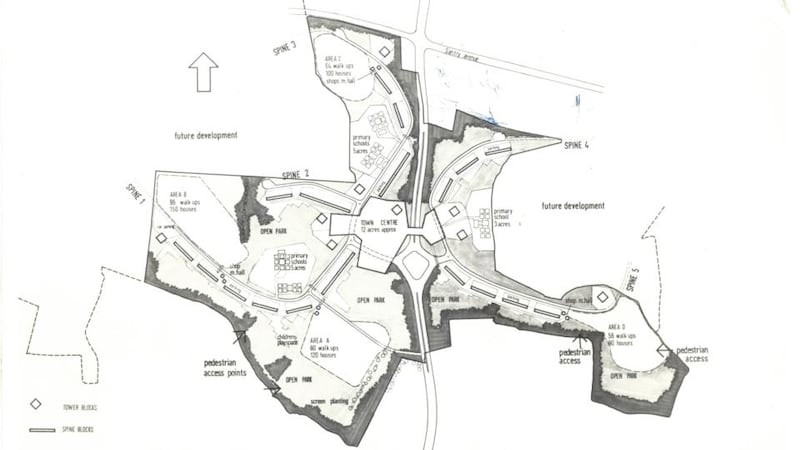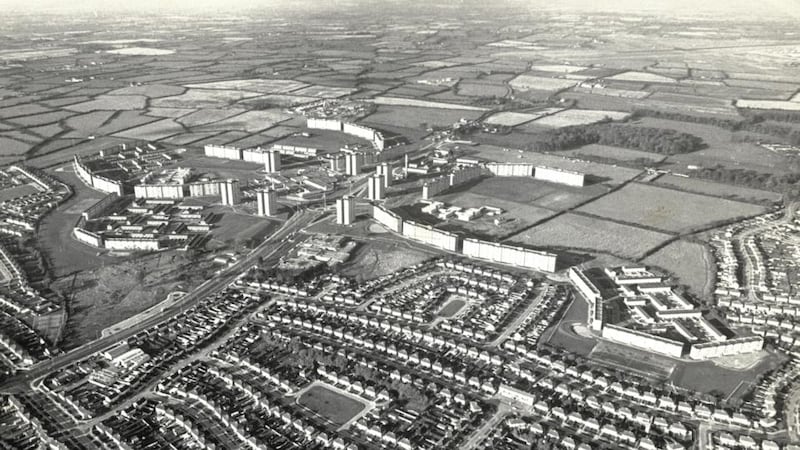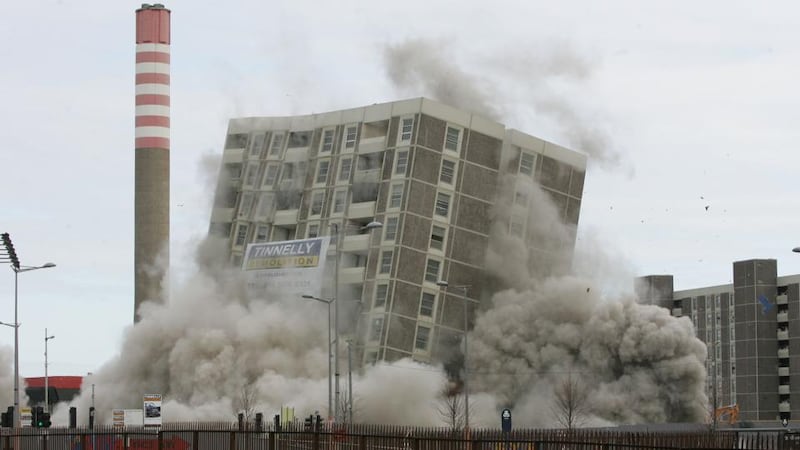In December 1963 The Irish Times carried a less than thrilling news story headed "Farmers study artificial hay-drying." It probably seemed immensely boring at the time. Only in retrospect does it seem interesting, because of the location of the hay-drying class: a farm in Ballymun.
A month later the paper carried a photograph of the members of the Irish Countrywomen’s Association Ballymun guild. And a month after that it reported that residents in this semirural area to the north of the city were “agitating against the building of Corporation houses in the locality and complaining that the value of houses there is dropping in anticipation”.
They were quickly reassured that Dublin Corporation did not yet have any such plans. And then, just three weeks later, on April 20th, 1964, the paper reported that Dublin Corporation was in fact actively considering a plan to build 3,000 units of system-built housing, along the lines of similar schemes in Paris, Stockholm and Copenhagen.
For the anxious residents of Ballymun village the killer lines were in the last paragraph: “The land around the former agricultural college at Ballymun . . . has been tentatively chosen for the system-building experiments.”
As the plans for Ballymun became literally concrete, the language of the scheme had a confident, technocratic ring
"Experiments" is a telling choice of word: it smacks of scientific modernity. And indeed, over 1964 and 1965, as the plans for Ballymun ceased to be tentative and became literally concrete, the language of the scheme had a confident, technocratic ring. There was much talk of the Lowton-Cubitt system of construction, of prestressed concrete blocks and light steel frames and stressed skin timber floors.
For those who knew about such things it was deeply impressive that Sir William Holford, widely regarded as the leading technocrat of town planning in postwar Britain, and the father of the modern industrial estate, would be "associated with the project in an overall consultancy capacity".

Great leap forward
Maoist China had just completed its (in fact disastrous) Great Leap Forward into accelerated industrial modernity, and Ballymun’s transformation from hay-drying demonstrations to Lowton-Cubitt construction in a matter of months can be seen as part of Ireland’s imagined great leap forward.
The publication of TK Whitaker’s groundbreaking plan Economic Development and the accession of Seán Lemass as taoiseach had ignited a belated industrial revolution. Ireland was sick of being a rural idyll of underdevelopment and mass emigration. The desire to be modern was overwhelming. Hard as it is to reconcile with the later history of the place, Ballymun was part of the new optimism. Thousands of families would move not just from Dublin’s dark, disgraceful slums to bright, airy towers with cool lifts, a swimming pool and an ice rink but also from an era of hopelessness into a long-promised but long-delayed future.
Not everyone, it is true, was entirely taken with this optimistic vision. On February 8th, 1965, in one of his last Cruiskeen Lawn columns for The Irish Times, Myles na gCopaleen (aka Flann O’Brien/Brian O’Nolan) made a grim prophecy: “Another spasm of ‘planning’ has taken possession of the notorious Department of Local Government Board. Again faithfully following British improvisation, a ‘new town’ is going to be run up in a jiffy in the Ballymun area, and thousands of indigent town dwellers, who have harmed nobody, permanently exiled there. It will inevitably and quickly become a new concrete slum, like Crumlin and Ballyfermot, and workers drafted there can face a lifetime of poverty by having a substantial slice of their earnings earmarked for extortionate bus fares. Scarcity and malnutrition will be the lot of their families.”
Myles na gCopaleen’s pessimism
Myles’s pessimism must have seemed ridiculous even to many of his devoted readers. After all, the Cubitt group, developers of the system and members of the consortium that would build the scheme, conjured up a kind of rus-in-urbe Utopia: “Ballymun will set a new standard in European housing architecture because it will show that system-built architecture need not be regimented nor inhuman in scale.”
Those fortunate enough to be able to live in this “town planning showpiece” would find themselves in a “vast park with huge open landscaped spaces, natural woodland and few traffic dangers”.
There was a need to declare the scheme not merely a practical solution to Dublin's housing crisis but also a beacon for all of Europe
This hubris was taken up by the ruling power, Fianna Fáil. Perhaps as a way of hiding the reality that Ballymun was essentially following an English model of urban planning for the masses, there was a need to declare the scheme not merely a practical solution to Dublin’s housing crisis but also a beacon for all of Europe.
Neil Blaney, the minister for local government, in formally launching the scheme in 1965 (perhaps aptly on April Fool's day), declared it not only the greatest ever undertaken in Ireland but also "a model for ourselves and other countries".
This ultraconfidence was carried even further in 1966, during the celebrations of the 50th anniversary of the 1916 rising, when the seven 15-storey Ballymun towers were named after the seven signatories of the Proclamation of the Irish Republic, implying that Ballymun was an achievement of which they would have been proud. When a delegation of young local government officials from Berlin visited Ireland in July 1966 they were taken to see Ballymun, obviously as a sign of what the new Ireland could achieve and their own city might wish to emulate.

In all of this what was seldom mentioned were people. Myles na gCopaleen, even in his satirically exaggerated way, at least thought about how these “exiles” were going to afford bus fares. Nobody else seems to have thought through who these Ballymuners were going to be and how they might live and what they might need beyond their system-built showpiece flats.
Blayney thought about them enough to hope that they would not call their home Ballymun at all but would instead adopt the more upbeat-sounding Ardglas. But, asked about the facilities they would need, his reply was worryingly vague: “They hoped to have all the other amenities needed there available when homes were built or shortly afterwards.”
It was not the fault of the hopeful families that their promised land of woods and blooming landscapes, of ice rinks and cinemas and a light rail system, never materialised
Shortly afterwards meant, in some cases, never. It was not the fault of the hopeful families who began to move in to Ballymun 50 years ago – the scheme also included 19 eight-storey and 10 four-storey blocks – that their promised land of woods and blooming landscapes, of ice rinks and cinemas and a light rail system, never materialised. Or that the links between the supposed “new town” – actually a misnomer for a giant housing estate – and the rest of the city never developed sufficiently for Myles na gCopaleen’s prophecy of permanent exile to feel quite so ridiculous after all. Ballymun may never have been merely the “concrete slum” he predicted. But within less than 20 years it had become the reservation for many of the poorest and most transient people on Dublin’s housing list.

Single mothers
By the mid 1980s traditional families were already reluctant to settle in Ballymun and the tower blocks were disproportionately occupied by single mothers and their children, by single men (many recently moved from institutional care) and by people who had been homeless. Few of them had access to the income, jobs, services and supports they needed. And because they were often politically disempowered the authorities did not feel pressure to maintain the blocks to a decent standard.
A key moment came in 1984, when Bank of Ireland announced that it was closing its Ballymun branch. Mainstream Ireland was withdrawing from Ballymun. The first of the towers was demolished in 2004; all had gone by 2015, just under half a century after their construction. (The area is still home to more than 22,000 people.)
Perhaps the warning was there in that early use of the word “experiments”. Ballymun was part of Ireland’s experiment with modernity, one that has never found a formula that works for the whole population. The people of Ballymun were unknowingly taking part in somebody else’s experiment with their lives. As with all experiments, the ones that don’t work are quickly discarded.

















